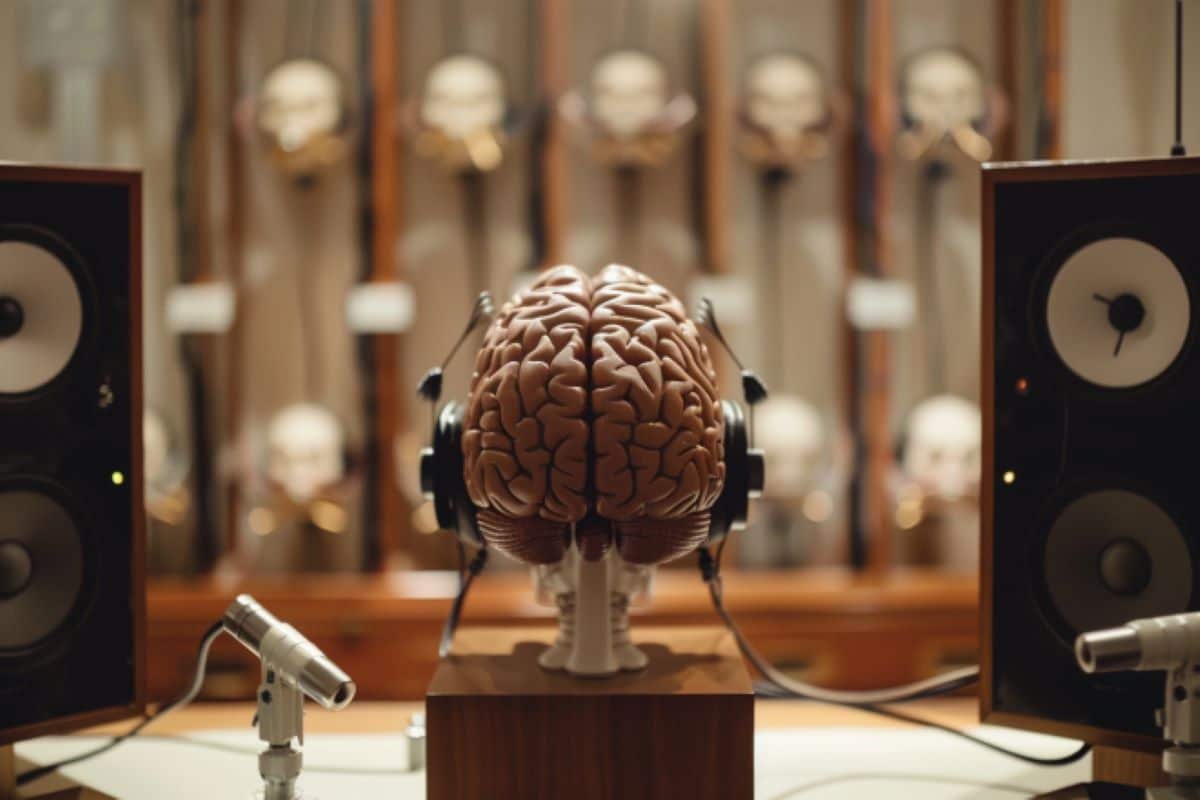Summary: Researchers discovered how the brain translates sounds into actions, a key to understanding sensory decision-making. Their study reveals that both sensory and future action-related signals are present in the cortex, challenging previous beliefs that these areas are functionally distinct.
By using a unique experimental setup involving mice, the researchers were able to distinguish the signals related to hearing from those associated with decision-making. This insight deepens our understanding of the brain’s complex response to auditory stimuli and its impact on behavior.
Key Facts:
- The cortex processes sensory information and manages actions, with action-related signals also appearing in sensory areas.
- The study employed a novel task that required mice to distinguish sounds and make decisions, allowing researchers to isolate sensory and decision-related brain signals.
- Researchers found that movement-related signals in the auditory cortex are influenced by higher brain centers and may not directly cause actions but could help integrate sensory perception with expected actions.
Source: Champalimaud Centre for the Unknown
You hear a phone ring or a dog bark. Is it yours or someone else’s? You hear footsteps in the night — is it your child, or an intruder? Friend or foe? The decision you make will determine what action you take next.
Researchers at the Champalimaud Foundation have shed light on what might be going on in our brains during moments like these, and take us a step closer to unravelling the mystery of how the brain translates perceptions into actions.
Every day, we make countless decisions based on sounds without a second thought. But what exactly happens in the brain during such instances?
A new study from the Renart Lab, published in Current Biology, takes a look under the hood.
Their findings deepen our understanding of how sensory information and behavioural choices are intertwined within the cortex — the brain’s outer layer that shapes our conscious perception of the world.
The cortex is divided into regions that handle different functions: sensory areas process information from our environment, while motor areas manage our actions. Surprisingly, signals related to future actions, which one might expect to find only in motor areas, also appear in sensory ones.
What are movement-related signals doing in regions dedicated to sensory processing? When and where do these signals emerge? Exploring these questions could clarify the origin and role of these perplexing signals, and how they do — or don’t — drive decisions.
A Different Approach
The researchers tackled these queries by devising a task for mice. Postdoc Raphael Steinfeld, the study’s lead author, picks up the story: “To unravel what signals related to future actions might be doing in sensory areas, we thought carefully about the task mice would have to perform.
“Previous studies often relied on “Go-NoGo” tasks, where animals report their choice by either making an action, or not moving, depending on the identity of the stimulus.
“This setup, however, mixes up signals linked to specific movements with those related to just moving in general. To isolate signals for specific actions, we trained mice to decide between one of two actions. They had to decide if a sound was high or low compared to a set threshold and report their decision by licking one of two spouts, left or right”.
However, this wasn’t sufficient.
“Mice quickly learn this task, often responding as soon as they hear the sound”, Steinfeld continues.
“To separate brain activity related to the sound from that related to the response, we introduced a critical half-second delay. During this interval, the mice had to withhold their decision.
“Crucially, this delay allowed us to temporally separate brain activity linked to the stimulus from that linked to the choice, and track how movement-related neural signals unfolded over time from the initial sensory input”.
“To dissect neural representations of stimulus and choice, it was also important to design an experiment challenging enough to allow the mice to make mistakes. A 100% success rate would blur the distinction between stimulus and choice, as each stimulus would always elicit the same response.
“By creating the potential for errors, we could tease apart the neural encoding of the sound from the decisions made”.
For instance, in cases where the mice heard the same tone but made different decisions (correct or incorrect), they could examine whether a neuron’s activity varied between the two actions. If so, it would indicate that the neuron encoded information about the choice.
Deep Connections
After six months of rigorous training, the researchers could finally begin recording neural activity in mice as they performed the task. They focused on the auditory cortex, the part of the cortex responsible for processing what we hear, which they had already shown was required for the task.
“The cortex of mice and humans is composed of six layers, each with specialised functions and distinct connections to other brain regions”, explains Alfonso Renart, principal investigator and the study’s senior author.
“Given that certain layers typically receive sensory information from brain regions, while others send input to motor centres, we simultaneously recorded activity across the layers of the auditory cortex—for the first time in a task like ours, in which sensory and motor signals could be cleanly separated”.
“We found that sensory- and choice-related signals displayed distinct spatial and temporal patterns”, Renart continues.
“Signals related to sound detection appeared quickly but faded fast, vanishing around 400 milliseconds after the sound was presented, and were distributed broadly across all cortical layers.
“In contrast, choice-related signals, which indicate the movement the mouse is about to make, emerged later, before the decision was executed, and were concentrated in the cortex’s deeper layers”.
However, despite the temporal separation between stimulus and choice activity, further analysis revealed an intriguing connection: neurons that responded to a specific sound frequency also tended to be more active for the actions associated with those sounds.
As Steinfeld explains, “For instance, a neuron that reacts to high frequencies might activate more for a rightward lick in one mouse and a leftward lick in another, depending on how each was trained, since we switched the sound-action contingency.
“This variability across different animals shows that the activity isn’t hardwired but adapts through experience. These neurons learn to increase their activity for whatever action is appropriate based on their preferred sound frequency”.
Origin and role of choice signals
So, what might the origin of these choice signals in the auditory cortex be?
“Interestingly”, notes Renart, “the early sensory signals in the auditory cortex don’t seem to predict the mice’s eventual choice, and the choice signals emerge significantly later.
“This suggests that the sensory signals in the auditory cortex don’t directly cause the mice’s actions, and that the choice signals we observe are likely computed elsewhere in higher brain regions involved in planning or executing movements, which then send their feedback to the auditory cortex”.
But if these movement signals don’t dictate actions, what role could they play? Perhaps they serve mainly to integrate and relay information. For instance, these signals could adjust the brain’s perception to align with an unfolding decision, enhancing the stability of what we perceive.
Alternatively, they could prime the brain for the expected sensory outcomes of actions, like the noise made by moving, ensuring our sensory experiences match our movements.
Yet, these hypotheses remain to be verified.
“One might wonder, if the sensory signals of the auditory cortex don’t directly inform choices, and the choice signals we observe there aren’t actually produced by it, then what exactly is the purpose of the auditory cortex?”, Renart muses.
“We could speculate that the auditory cortex is more concerned with constructing a conscious experience of sound than with sensory-motor transformation, but that’s a story for another day”.
Still, a causal role cannot be ruled out, particularly since the deeper layers of the auditory cortex transmit information to the posterior striatum, part of the brain’s control centre for habits and movements.
Future studies will aim to pinpoint the precise origins of these movement signals and whether they are indeed causal to behaviour.
For now, we can add another piece to the puzzle of how brains convert perception to action, and the internal mechanisms at work when you next hear footsteps in the night.
About this auditory neuroscience research news
Author: Hedi Young
Source: Champalimaud Centre for the Unknown
Contact: Hedi Young – Champalimaud Centre for the Unknown
Image: The image is credited to Neuroscience News
Original Research: Open access.
“Differential representation of sensory information and behavioral choice across layers of the mouse auditory cortex” by Raphael Steinfeld et al. Current Biology
Abstract
Differential representation of sensory information and behavioral choice across layers of the mouse auditory cortex
Highlights
- Stimulus-related information is widespread across the layers of the auditory cortex
- Stimulus-related information is transient and disappears within a few hundred ms
- Choice-related information appears later, but only in the deep layers
- Choice-related information is learned and reflects task contingencies
Summary
The activity of neurons in sensory areas sometimes covaries with upcoming choices in decision-making tasks. However, the prevalence, causal origin, and functional role of choice-related activity remain controversial.
Understanding the circuit-logic of decision signals in sensory areas will require understanding their laminar specificity, but simultaneous recordings of neural activity across the cortical layers in forced-choice discrimination tasks have not yet been performed.
Here, we describe neural activity from such recordings in the auditory cortex of mice during a frequency discrimination task with delayed report, which, as we show, requires the auditory cortex.
Stimulus-related information was widely distributed across layers but disappeared very quickly after stimulus offset.
Choice selectivity emerged toward the end of the delay period—suggesting a top-down origin—but only in the deep layers.
Early stimulus-selective and late choice-selective deep neural ensembles were correlated, suggesting that the choice-selective signal fed back to the auditory cortex is not just action specific but develops as a consequence of the sensory-motor contingency imposed by the task.

Dr. Debi Johnson is a medical expert and health journalist dedicated to promoting well-being. With a background in medicine, she offers evidence-based insights into health trends and wellness practices. Beyond her reporting, Dr. Debi enjoys hiking, yoga, and empowering others to lead healthier lives.







